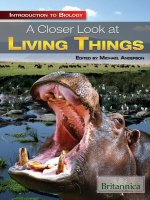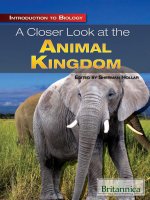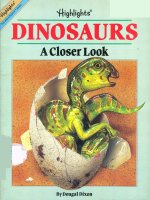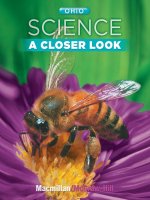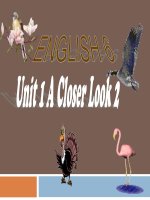Macmillan 08 SCIENCE a closer look g2
Bạn đang xem bản rút gọn của tài liệu. Xem và tải ngay bản đầy đủ của tài liệu tại đây (39.39 MB, 286 trang )
Program Authors
Dr. Dorothy J. T. Terman
Dr. Jay K. Hackett
Science Curriculum Development Consultant
Former K–12 Science and Mathematics Coordinator
Irvine Unified School District, CA
Irvine, CA
Professor Emeritus of Earth Sciences
University of Northern Colorado
Greeley, CO
Dr. Richard H. Moyer
Professor of Science Education and
Natural Sciences
University of Michigan–Dearborn
Dearborn, MI
Dr. JoAnne Vasquez
Elementary Science Education Consultant
NSTA Past President
Member, National Science Board
and NASA Education Board
Dr. Gerald F. Wheeler
Executive Director
National Science Teachers Association
Bank Street College of Education
New York, NY
Contributing Authors
Dr. Sally Ride
Sally Ride Science
San Diego, CA
Mulugheta Teferi, M.A.
Lucille Villegas Barrera, M.Ed.
Principal, Gateway Middle School
Center of Math, Science, and Technology
St. Louis Public Schools
St. Louis, MO
Elementary Science Supervisor
Houston Independent School District
Houston, TX
Dinah Zike, M.Ed.
Dinah Might Adventures LP
San Antonio, TX
Kathryn LeRoy, M.S.
Executive Director
Division of Mathematics and Science Education
Miami-Dade County Public Schools, FL
Miami, FL
American Museum
of Natural History
New York, NY
Contributing Writer
Ellen C. Grace, M.S.
Consultant
Albuquerque, NM
Students with print disabilities may be eligible to obtain an accessible, audio version of the pupil edition of this
textbook. Please call Recording for the Blind & Dyslexic at 1-800-221-4792 for complete information.
A
Copyright © 2008 by The McGraw-Hill Companies, Inc. All rights reserved.
Except as permitted under the United States Copyright Act, no part of this
publication may be reproduced or distributed in any form or by any means, or
stored in a database or retrieval system, without prior permission of the publisher.
Send all inquiries to:
Glencoe/McGraw-Hill
8787 Orion Place
Columbus, OH 43240-4027
ISBN: 978-0-02-287196-3
MHID: 0-02-287196-9
Printed in the United States of America.
1 2 3 4 5 6 7 8 9 10 (027/043) 11 10 09 08 07
ii
Content Consultants
Editorial Advisory Board
Paul R. Haberstroh, Ph.D.
Cathy Constance
Mary Ellen Murray
Mohave Community College
Lake Havasu City, AZ
Science Coordinator
Youngstown City Schools
Youngstown, OH
Science Curriculum Coordinator
Parma City Schools
Parma, OH
Kevin Cornell
Kevin Stinson
Teacher
Menlo Park Elementary
Huber Heights City Schools
Huber Heights, OH
Science Manager, K-12
Cincinnati City Schools
Cincinnati, OH
Carolyn Day
K-5 Science Curriculum Coordinator
Cleveland Municipal Schools
Cleveland, OH
Timothy Long
School of Earth and Atmospheric
Sciences
Georgia Institute of Technology
Atlanta, GA
Rick MacPherson, Ph.D.
Program Director
The Coral Reef Alliance
San Francisco, CA
Hector Córdova Mireles, Ph.D.
Physics Department
California State
Polytechnic University
Pomona, CA
Charlotte A. Otto, Ph.D.
Department of Natural Sciences
University of Michigan-Dearborn
Dearborn, MI
Paul Zitzewitz, Ph.D.
Department of Natural Sciences
University of Michigan-Dearborn
Dearborn, MI
Director of School Improvement
Past Science and Math Supervisor
Dayton Public Schools
Dayton, OH
Chris Doolittle
Science Resources
Westerville City Schools
Westerville, OH
Jim Hooper
Science Curriculum Leader
Vandalia-Butler City Scools
Vandalia, OH
James Lay
Teacher
Dayton Public Schools
Dayton, OH
Chris Moore-Goad
Math and Science Specialist
Kettering City Schools
Kettering, OH
Elizabeth Voit
Tracie Walsh
Teacher
Oakview Elementary
Kettering City Schools
Kettering, OH
Deb Wickerham
Findlay City Schools
Findlay, OH
Jeff Winslow
Science Supervisor
Talawanda Schools
Oxford, OH
Missi Zender, Ph.D.
Science Resource Specialist
Summit County ESC
Cuyahoga Falls, OH
The American Museum of Natural History in New York City is one of the world’s preeminent scientific, educational, and
cultural institutions, with a global mission to explore and interpret human cultures and the natural world through scientific
research, education, and exhibitions. Each year the Museum welcomes around four million visitors, including 500,000
schoolchildren in organized field trips. It provides professional development activities for thousands of teachers; hundreds
of public programs that serve audiences ranging from preschoolers to seniors; and an array of learning and teaching resources for use in
homes, schools, and community-based settings. Visit www.amnh.org for online resources.
is a trademark of The McGraw-Hill Companies, Inc.
iii
iv
v
BE A SCIENTIST
Ohio: A Closer Look . . . . . . . . . . . . . . . . . . . . . . . . . . . . . . . 20
Cuyahoga Valley National Park
Peregrine Falcons on the Rhodes Tower
CHAPTER 1
Plants . . . . . . . . . . . . . . . . . . . . . . . . . . . . . . . . . . . . . . . . 24
Lesson 1
What Living Things Need . . . . . . . . . . . . . . . . . 26
• Inquiry Skill Builder . . . . . . . . . . . . . . . . . . . . 32
Lesson 2 Plants Make New Plants . . . . . . . . . . . . . . . . . . 34
• Writing in Science • Math in Science . . . . . . 42
Lesson 3 How Plants Are Alike and Different . . . . . . . . 44
Reading in Science . . . . . . . . . . . . . . . . . . . . . . 50
I Read to Review: Peach Tree . . . . . . . . . . . . . . . . . . . . . . . 52
Chapter 1 Review and Standards Practice . . . . . . . . . . . . . . 56
CHAPTER 2
Animals . . . . . . . . . . . . . . . . . . . . . . . . . . . . . . . . . . . . . . 58
Lesson 1
Animal Groups. . . . . . . . . . . . . . . . . . . . . . . . . . 60
• Inquiry Skill Builder . . . . . . . . . . . . . . . . . . . . 66
Lesson 2 Animals Grow and Change . . . . . . . . . . . . . . . . 68
Reading in Science . . . . . . . . . . . . . . . . . . . . . . 74
Lesson 3 Staying Alive . . . . . . . . . . . . . . . . . . . . . . . . . . . 76
• Writing in Science • Math in Science . . . . . . 82
I Read to Review: So Many Animals! . . . . . . . . . . . . . . . . . 84
Chapter 2 Review and Standards Practice . . . . . . . . . . . . . 88
vi
CHAPTER 3
Looking at Habitats . . . . . . . . . . . . . . . . . . . . . . . . . . 90
Lesson 1
Places to Live . . . . . . . . . . . . . . . . . . . . . . . . . . . 92
• Inquiry Skill Builder . . . . . . . . . . . . . . . . . . . . 98
Lesson 2 Food Chains and Food Webs . . . . . . . . . . . . . 100
• Writing in Science • Math in Science . . . . . 106
Lesson 3 Habitats Change . . . . . . . . . . . . . . . . . . . . . . . 108
Be a Scientist . . . . . . . . . . . . . . . . . . . . . . . . . . .1 1 8
I Read to Review: Changing Habitats. . . . . . . . . . . . . . . . 120
Chapter 3 Review and Standards Practice . . . . . . . . . . . . 124
Unit Literature The Seed . . . . . . . . . . . . . . . . . . . . . . . . 126
vii
Ohio: A Closer Look . . . . . . . . . . . . . . . . . . . . . . . . . . . . . . 130
Cincinnati Observatory
The John H. Glenn Research Center at Lewis Field
CHAPTER 4
Earth in Space . . . . . . . . . . . . . . . . . . . . . . . . . . . . . . . . 134
Lesson 1
Day and Night . . . . . . . . . . . . . . . . . . . . . . . . . 136
• Inquiry Skill Builder . . . . . . . . . . . . . . . . . . . 142
Lesson 2 Why Seasons Happen . . . . . . . . . . . . . . . . . . . 144
• Writing in Science • Math in Science . . . . . 150
Lesson 3 The Moon and Stars . . . . . . . . . . . . . . . . . . . . 152
• Be a Scientist . . . . . . . . . . . . . . . . . . . . . . . . 160
I Read to Review: Our Moving Earth . . . . . . . . . . . . . . . . 162
Chapter 4 Review and Standards Practice . . . . . . . . . . . . 166
viii
CHAPTER 5
Observing Weather. . . . . . . . . . . . . . . . . . . . . . . . . . . 168
Lesson 1
Weather . . . . . . . . . . . . . . . . . . . . . . . . . . . . . . 170
• Writing in Science • Math in Science . . . . . 176
Lesson 2 The Water Cycle . . . . . . . . . . . . . . . . . . . . . . . 178
• Inquiry Skill Builder . . . . . . . . . . . . . . . . . . . 184
Lesson 3 Changes in Weather . . . . . . . . . . . . . . . . . . . . 186
Reading in Science . . . . . . . . . . . . . . . . . . . . . 192
I Read to Review: Earth’s Water Cycle . . . . . . . . . . . . . . . 194
Chapter Review and Standards Practice . . . . . . . . . . . . . . 198
Unit Literature Sun Flakes . . . . . . . . . . . . . . . . . . . . . . . 200
ix
Ohio: A Closer Look . . . . . . . . . . . . . . . . . . . . . . . . . . . . . . 204
Marblehead Lighthouse
Dayton Philharmonic Orchestra
CHAPTER 6
Energy . . . . . . . . . . . . . . . . . . . . . . . . . . . . . . . . . . . . . . 208
Lesson 1
Sound . . . . . . . . . . . . . . . . . . . . . . . . . . . . . . . . 210
• Writing in Science • Math in Science . . . . . 218
Lesson 2 Light. . . . . . . . . . . . . . . . . . . . . . . . . . . . . . . . . 220
• Be a Scientist . . . . . . . . . . . . . . . . . . . . . . . . 226
I Read to Review: Energy Poem . . . . . . . . . . . . . . . . . . . . 228
Chapter Review and Standards Practice . . . . . . . . . . . . . . 232
Unit Literature Popcorn Hop . . . . . . . . . . . . . . . . . . . . . 234
Careers in Science . . . . . . . . . . . . . . . . . . . . . . . . . . . . . . . 236
x
xi
Life Sciences
CHAPTER 1
CHAPTER 3
Explore Activities
Explore Activities
What do leaves need? . . . . . . . . . .27
Where do animals live? . . . . . . . . 93
What are the parts of a seed? . . . .35
What do animals eat? . . . . . . . . . . 101
How do roots grow? . . . . . . . . . . .45
What happens when
habitats change? . . . . . . . . . . . . . 109
Quick Labs
Plants and Water . . . . . . . . . . . . . .30
Seed Protection . . . . . . . . . . . . . . .38
Plants and Light . . . . . . . . . . . . . . .48
Quick Labs
Plant and Animal Habitats . . . . . 97
Food Chain Fun . . . . . . . . . . . . . . 103
Habitat Comic Strip . . . . . . . . . . . .114
CHAPTER 2
Explore Activities
How can we put animals
into groups? . . . . . . . . . . . . . . . . . . 61
How are babies and adults
alike and different? . . . . . . . . . . . .69
How does the color of an animal
keep it safe? . . . . . . . . . . . . . . . . . .77
Quick Labs
Make an Animal Model . . . . . . . . .65
Act Out an Animal Life Cycle . . . . 71
Animal Eyes . . . . . . . . . . . . . . . . . . 81
xii
Be a Scientist investigations and Focus on Skills
skill builders are found in the Activities Flipchart.
Earth and
Space Sciences
CHAPTER 4
CHAPTER 5
Explore Activities
Explore Activities
Why can’t we see the
Sun at night? . . . . . . . . . . . . . . . . 137
How does the weather
change each day? . . . . . . . . . . . . . 171
What clothes do people
wear in each season? . . . . . . . . . . 145
Where did the water go? . . . . . . 179
How do we see the
Moon at night? . . . . . . . . . . . . . . 153
Quick Labs
Moon Flip Book . . . . . . . . . . . . . . 140
Seasons . . . . . . . . . . . . . . . . . . . . . 147
How can clouds help
predict the weather? . . . . . . . . . . 187
Quick Labs
Make a Wind Sock . . . . . . . . . . . . 174
Model the Water Cycle . . . . . . . . 182
Make a Thunder Model . . . . . . . . 190
Stars . . . . . . . . . . . . . . . . . . . . . . . 158
FM_Caption_wArrow
xiii
Physical Sciences
CHAPTER 6
Explore Activities
How is sound made? . . . . . . . . . . 2 1 1
What does light pass through? . . . .221
Quick Labs
Tuning Fork Ripples . . . . . . . . . . . 213
Prism Rainbow . . . . . . . . . . . . . . . 224
xiv
Some tree frogs lay their eggs
on leaves floating on water.
SI-A. Ask a testable question. SI-B. Design and conduct a simple investigation
to explore a question. SI-C. Gather and communicate information from careful
observations and simple investigation through a variety of methods.
Do you see the frog? How does
it stay on the lily pad?
2
ENGAGE
SI-5. Use evidence to develop explanations of scientific investigations.
(What do you think? How do you know?)
How can a frog float
on a lily pad?
You need
What to Do
Predict. Where should you
place the frog on the lily pad
so that the frog stays dry?
paper plate
Make a Model. Color a paper
plate green with crayon. This
will be the lily pad.
green
crayon
Be Careful. Poke a small hole
near the edge of the lily pad.
Tie a six-inch piece of string
through the hole.
scissors
Place the lily pad in a pan of
water with the string below it.
Record Data. Draw and write
down where you placed
the frog.
string
pan of water
Step
toy frog
SI-7. Use appropriate tools and simple equipment/instruments to safely gather
scientific data (e.g., magnifiers, non-breakable thermometers, timers, rulers,
balances and calculators and other appropriate tools).
3
EXPLORE
What do scientists do?
Scientists use many skills when they
work. You wondered about the frog
on a lily pad. Just as you did, a scientist
might make a model. A model shows
how something in real life looks.
Scientists use other skills that you
can use, too. Scientists observe, or look
carefully. A scientist who observes a
pond can find many amazing things.
Scientists observe the height,
color, and shape of plants near
the pond.
cattails
pond grass
4
EXPLAIN
water iris
Scientists compare things by telling
how they are alike or different. Look
at the two pond animals on this page.
How might a scientist compare them?
Look closely. Both animals have
wings. They both live near ponds.
But they are different in many other
ways. Scientists find ways to classify
things, or put them in groups. Insects
and birds are different animal groups.
5
EXPLAIN
How do scientists work?
Look at all the eggs a scientist found
near a pond! Scientists can measure how
large or how heavy the eggs are. When
you measure, you find out how long or
how heavy something is. You can also find
out how hot or how cold something is.
The facts scientists find are called
data. When scientists record data,
they write down what they observe.
6
EXPLAIN
After scientists collect data, they can
put their data in order. Put things in order
means to arrange them in some way. For
example, you can order the eggs by their
size. Which egg is smallest? Which is largest?
Another skill scientists use is infer.
When you infer, you use what you know
to figure something out. Can you infer
which eggs belong to the
animals on this page?
frog
duck
turtle
robin
7
EXPLAIN
How do scientists learn new things?
Scientists learn new things by
investigating. When you investigate,
you make a plan and try it out.
Scientists start by asking a question.
They predict what the answer might
be. When you predict, you use what
you know to tell what you think will
happen.
Look at the pictures of the tadpole
and young frog. What do you predict
the young frog will look like next?
?
tadpole
8
EXPLAIN
young frog
?
When you draw conclusions, you
use what you observe to explain what
happens. Scientists draw conclusions.
They conclude tadpoles live in the
water, grow legs, and climb onto land.
Scientists communicate their
ideas to other people. When you
communicate, you write, draw, or tell
your ideas.
1. Which skill helps scientists put things
into groups?
2. Write about what new things you might
want to learn if you were a scientist.
9
EVALUATE
This frog can swim! How else can a frog
move? Scientists ask questions like this.
They follow certain steps to find the answers.
10
ENGAGE
SWK-1. Describe that scientific investigations generally work the same way
under the same conditions.
